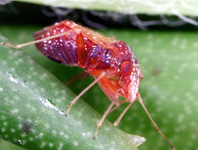Abstract
Eumastacinae are well-recognized because most genera feature showy colors, and because of particular morphological characteristics of the phallic complex. This orthopteran subfamily includes the genus Caenomastax, distributed in mid-elevations in the departments of Boyacá, Cundinamarca and Santander in Colombia. Three new species are described for this genus: Caenomastax similis n. sp., C. bimaculata n. sp. and C. magdalenensis n. sp. A phylogenetic analysis was performed based on morphological characters for 10 species (five ingroup and five outgroup) and 61 characters, which comprised external and genital morphology. Among the main results cast by this analysis was the proposition of Hebardomastax n. gen., within which C. atopa was previously placed, and a clarification was made on the status of the genus Zeromastax. Using the analyzed characters, an identification key is proposed for the genus.
References
Amédégnato, C. (1976) Structure et evolution des genitalia chez les acrididae et familles apparentées. Acrida, 5 (1), 1–15.
Amédégnato, C. (1977) Étude des Acridoidea centre et sud américains (Catantopinae sensu lato). Anatomie des genitalia, classification, répartition, phylogénie. Doctoral Thesis, Université Pierre et Marie Curie, Paris, 385 pp. [mimeo]
Bremer, K. (1994) Branch support and tree stability. Cladistics, 10, 235–304.
http://dx.doi.org/10.1111/j.1096-0031.1994.tb00179.xCadena-Castañeda, O.J. & Monzón-Sierra, J. (2014) Studies in Guatemalan Caelifera: New grasshoppers and monkey grasshoppers (Orthoptera: Caelifera: Acridoidea & Eumastacoidea) and an updated checklist. Zootaxa, 3857 (3), 379–411.
http://dx.doi.org/10.11646/zootaxa.3857.3.3
Cadena-Castañeda, O.J. & Cardona, J.M. (2015) Introducción a los Saltamontes de Colombia (Orthoptera: Caelifera: Acrididea: Acridomorpha, Tetrigoidea & Tridactyloidea), 534 pp.
Descamps, M. (1971) Les Eumastacidae de Colombie. Revision des Paramastacinae et Eumastacinae (Acridomorpha, Eumastacoidea). Caldasia, 11 (51), 99–192.
Descamps, M. (1973) Révision des Eumastacoidea (Orthoptera) aux échelons des familles et des sous-familles (genitalia, répartition, phylogénie). Acrida, 2, 161–298.
Eades, D.C., Otte, D., Cigliano, M.M. & Braun, H. (2015) Orthoptera Species File Online. Version 5.0/5.0. Available from: http://Orthoptera.SpeciesFile.org (accessed 20 June 2015)
Farris, J.S. (1989) The retention index and homoplasy excess. Systematic Zoology, 38, 406–407.
http://dx.doi.org/10.2307/2992406Flook, P.K. & Rowell, C.H.F. (1997) The phylogeny of the Caelifera (Insecta, Orthoptera) as deduced from mtRNA gene sequences. Molecular Phylogenetics and Evolution. 8, 89–103.
http://dx.doi.org/10.1006/mpev.1997.0412Goloboff, P.A., Farris, J.S. & Nixon, K.C. (2008) TNT, a free program for phylogenetic analysis. Cladistics, 24, 774–786.
http://dx.doi.org/10.1111/j.1096-0031.2008.00217.xHebard, M. (1923) Studies in the Dermaptera and Orthoptera of Colombia. Third paper. Orthopterous family Acrididae. Transactions of the American Entomological Society, 49, 165–313, 8 pls.
Kluge, A.G. & Farris, J.S. (1969) Quantitative phyletics and evolution of anurans. Systematic Zoology, 18, 1–32.
http://dx.doi.org/10.2307/2412407Matt, S., Flook, P.K. & Rowell, C.H.F. (2008) A partial molecular phylogeny of the Eumastacoidea s. lat. (Orthoptera, Caelifera). Journal of Orthoptera Research, 17 (1), 43–55.
http://dx.doi.org/10.1665/1082-6467(2008)17[43:APMPOT]2.0.CO;2Nixon, K.C. (2002) Winclada. Version 1.00.08. Published by the author, Ithaca, New York.
Porras, M.F. (2007) Del carnaval al estereoscopio: Zeromastax (Orthoptera: Eumastacidae), un nuevo género de saltamontes payaso. Revista Colombiana de Entomología, 33 (1), 70–73.
Rehn, J.A.G. & Grant Jr., H.J. (1958) The phallic complex in the subfamilies of New World Eumastacidae and the family Tanaoceridae. Proceedings of the Academy of Natural Sciences, Philadelphia, 110, 301–319.
Song, H. & Mariño-Pérez, R. (2013) Re-evaluation of taxonomic utility of male phallic complex in higher-level classification of Acridomorpha (Orthoptera: Caelifera. Insect Systematics and Evolution, 44 (3–4), 241–260.
http://dx.doi.org/10.1163/1876312X-04402008Song, H., Amédégnato, C., Cigliano, M.M., Desutter-Grandcolas, L., Heads, S., Huang, Y., Otte, D. & Whiting, M.F. (2015) 300 million years of diversification: elucidating the patterns of orthopteran evolution based on comprehensive taxon and gene sampling. Cladistics, 31 (6), 1–31.
http://dx.doi.org/10.1111/cla.12116Varón, A. (2000) Saltamontes eumastácidos (Insecta: Orthoptera: Caelifera: Eumastacidae) de Colombia. Biota Colombiana, 1 (3), 261–266.

